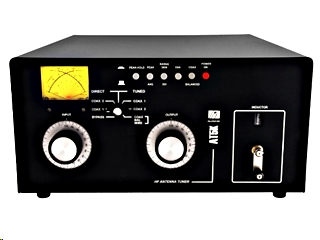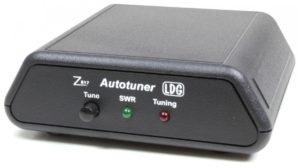In search of the “perfect” antenna.
A lot of off grid amateur radio involves compromises. We don’t have the same resources as grid-connected hams. Many off grid hams operate portable stations, which presents even more givebacks. One of the most common compromises is the antenna. When trying to go portable, having a “perfect” antenna is almost impossible. Even if you’re not portable, you probably have antenna challenges: Maybe you live in an apartment. Maybe you have to work within municipal ordinances or homeowner association restrictions. Maybe you have limited money (or an uncooperative spouse!). One way to make an imperfect antenna usable is with an antenna tuner. Antenna tuners are a misunderstood piece of hardware, especially in the realm of off grid amateur radio. Let’s try to sort it out.
What exactly does an antenna tuner do?
Every transmitter wants a specific value impedance load on its output. In this case the load is an antenna. Without getting too technical, impedance is a form of resistance where there is an opposition to current when voltage is applied. Impedance and its cousin reactance are found only in AC circuits (Yes, I know this is oversimplifying things. Please don’t pepper me with nit picky comments/emails). The unit is Ohms and the unit symbol is Z. For nearly all amateur equipment, the load (antenna) must be 50 Z for the transmitter to work properly. By the way, you’ll often see the symbol Ω (ohms) used to express impedance. This nomenclature is incorrect, but since it is so commonly (mis)used, it’s become unofficially accepted.
Sounds straightforward, right? Here’s the catch: Impedance varies with frequency. Even if you have the “perfect” antenna, it’s not going to be perfect everywhere on all bands. Impedance mismatches between the transmitter and the load (antenna) manifests itself in the form of a high standing wave radio (SWR). The farther you drift away from that “perfect” resonant 1:1 SWR frequency, the higher your SWR will be. SWR represents RF power reflected back to its source due to the difference in impedance between the energy source (transmitter) and the antenna. In extreme cases, the reflected power can damage the transmitter. This is the inefficiency an antenna tuner is designed to correct.
What an antenna tuner won’t do.
Way back when I was studying for my first ham ticket, an old Elmer wisely quipped, “all an antenna tuner does is lie to your radio!” He was absolutely right. Antenna tuners are not magic pixie dust for out of whack antennas. The deficiencies and compromises that existed before are still there. The only difference is that your radio will happily believe the lie and think it is transmitting into a perfect 50 ohm load, which technically it is.
An antenna tuner does not actually “tune” or make any electrical or physical changes to your antenna. All it does is create a correct 50 Z appearance for your transmitter no matter what the impedance of the antenna system really is. Think of it like the transmission on your car. You could not connect the engine directly to the wheels and expect the car to perform satisfactorily under all conditions. An an antenna tuner, like a car transmission, allows the power source to operate within a defined parameter even when the load varies.
I’ve seen a lot of inexperienced (or lazy) amateurs slap an antenna tuner on a compromised antenna and call it “fixed”. If you have no better options and must deploy a less-than-awesome antenna, then by all means use a tuner to make it good enough. It’s better than not being on the air at all! But to the extent that you can, fix the deficiencies at their source. Start out with the best antenna possible.
Manual and automatic antenna tuners.
Even though automatic and manual tuners perform the same basic function, amateurs should understand some important differences between the devices. An automatic tuner is literally as simple as pushing a button. It calculates the match required for lowest SWR and adjusts accordingly. On a manual tuner you have to adjust the settings yourself.
An automatic tuner (at least the modern ones) typically do not have variable capacitors and inductors. They have banks of fixed value components. A microprocessor switches between different combinations of the capacitors and inductors. This is the ticking or buzzing sound you hear. Eventually the tuner finds the best combination to provide a 50 Z load. The ticking stops and you can proceed with your transmission. The process must be repeated for any significant change in frequency. The operation is seamless; just press a button.
Automatic disadvantages.
The main disadvantage of automatic tuners is that there is a finite combination of possible settings. On a severely mismatched antenna system, your antenna tuner may have difficulty finding the 50 ohm sweet spot. Antenna tuners built into many popular radios are well known for this shortcoming. If the integrated automatic antenna tuner on your radio clicks and clicks but won’t pull the SWR down as far as you hoped, it’s because built in antenna tuners are only there to make minor tweaks. Anything more than that and you’ll need and external/outboard tuner as they typically offer a greater range of correction.
The manual option.
Manual tuners give you more flexibility. For example, if the “perfect” setting is between two fixed values in an autotuner, the computer cannot split the difference. It must choose one or the other. There will be a built-in factor of error. In a manual tuner, the operator can set the device to the exact best value. There is a natural level of refinement that cannot be duplicated by a computer because (theoretically) a manual tuner has an infinite number of settings.
Manual antenna tuners have the added benefit of making the operator feel like…an operator. It’s not plug and play. You have to know something and pay attention to what you’re doing. It creates a personal connection to operating radio that does not happen when you just push a button. Lastly, manual tuners are typically less expensive than comparable autos and do not require a separate power source unless there are other features on the device not related to the tuner, such as dial backlights or remote antenna switches.
There are not many disadvantages to a manual tuner other than you have to do the work yourself. I’ve used both manual and automatic antenna tuners and got good results from both. They each have their place; which is “better” depends on who you ask.
What we learned today.
- The unit for impedance is Ohms and the symbol is Z
- Most amateur transmitters require a 50 Z load.
- Impedance changes with frequency.
- An antenna tuner will not “fix” an inherently flawed antenna. It will only create an acceptable impedance load for the transmitter.
- Manual tuners with variable capacitors and inductors can be adjusted to an exact match.
- Automatic antenna tuners select combinations of fixed value capacitors and inductors. The match may not be as accurate as a manual tuner.


That’s just about the best and simplest explanation of what an antenna tuner does that I’ve ever read. Nicely written, Chris.
Good point about internal tuners – they generally can’t handle more extreme SWR situations. Every one is different, of course, but generally a lot of them can’t deal with an SWR that’s worse than about 2:1 or so. And in the long run, as you say, it isn’t really changing the efficiency of the antenna itself. That antenna is still inefficient and a lot of power is going to be wasted instead of being radiated.
BTW, there is still one auto tuner that uses variable capacitors and inductors, the Palstar HF-Auto. It uses stepper motors to drive the inductor and capacitor while a rather sophisticated little computer does the calculations based on SWR readings being taken on the fly as it adjusts the system. I have one and it’s a great piece of equipment. Pricy, though, about $1,500 new. And it’s a big beast, about the size of a large shoe box. But it’s an amazing piece of equipment and can tune up just about anything. I haven’t tried to hook it to the house’s rain gutters, but I really wouldn’t be surprised if it could get a match on a downspout
Speaking of antenna tuning, I’ve been playing with that mag loop antenna and wow, that thing is finicky sometimes. One thing they don’t tell you in the ads is that capacitance from your body or hand can be a serious factor in trying to tune it. I’ll get it dialed down to a 1:1.2 match, only to take my hand away from the knob and see the SWR jump up to 1:1.8 or higher. And there doesn’t seem to be much consistency in when it will do it or how bad it will be.
I have an old 1990s era Yeasu auto tuner that also uses motors to physically move variable components but has the option of overriding the computer and making the adjustments by hand. Such devices still exist but as you point out they are rare and expensive.
Thanks for affirming my comments on internal auto tuners. My FT-950 has one and it does not have the guts to do any more than make minor corrections. Always start with the best antenna you can fly because a crappy antenna with a tuner on it is still a crappy antenna.
“Always start with the best antenna you can fly because a crappy antenna with a tuner on it is still a crappy antenna.” That ought to be pasted on the front panel of every transceiver . Any antenna is better than no antenna, but a *good* antenna is worth its weight in gold.
Speaking of antennas, the woefully inefficient Comet 250 mutliband vertical I had up in the backyard came down and the GAP Titan DX vertical went up last night! Finally. I’ve only had that thing laying around for about four years. Still need to get get the counterpoise installed and coax run to it and the lighting arrestors and all that hooked up, but that should only take me, oh, another two years or so. Will be interesting to compare that to my OCFD.
I lost my fan dipole in a storm last winter and have not yet decided on a replacement. For now all I have for HF is a collection of portable antennas.
If you’re looking for a manufactured antenna I’d recommend a Buckmaster OCFD. They’re too expensive new (IMO) but you can find ’em for half price or less if you watch the hamfests and on-line markets. I’ve had one for years now and it’s worked well for me for both NVIS and DX. Can cover all HF bands. My SWR is nothing to brag about but that’s because I have it way too low to the ground, about 10 ft. Get it up to 30 ft or higher and it works much, much better.